ECommerce is one of the largest industries today. One of the first names that come to mind when you mention eCommerce is, Etsy. With over 377.4 million of average traffic per month, Etsy business model is actually impressive.
After all, there aren’t many platforms that generated $1,164,401 in just 6 months of 2022. And these numbers are only growing as we proceed with 2023.
Etsy’s Mission Statement: To keep commerce human. (Quote)
In fact, success of the etsy e-commerce platform has attracted a lot of people from across the United States of America as well as the rest of the world to enquire about etsy business model, how it makes money and just the entire platform in general.
So, if you are one of these, this blog is for you. Here we shall be discussing all you need to know about Etsy, its working, revenue model, partners, and so on.
Therefore, with this being said, let’s get right into it, starting with a brief introduction.
Introduction To Etsy – eCommerce Platform
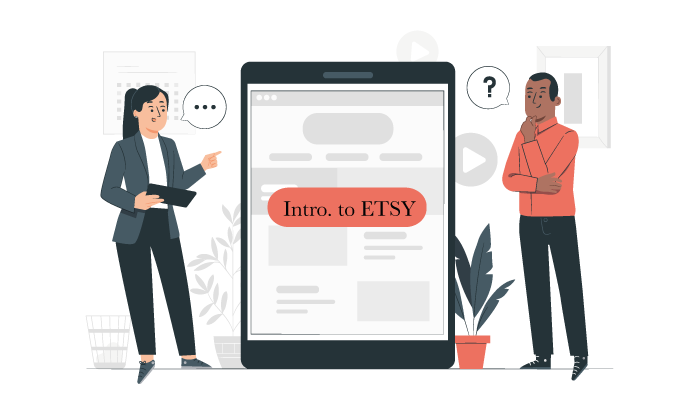
Before we discuss the Etsy business model in detail, let’s first discuss a bit about the platform.
ETSY is an e-commerce platform based in the USA. In their own words, “Etsy is the global marketplace for unique and creative goods. It’s home to a universe of special, extraordinary items, from unique handcrafted pieces to vintage treasures”
As such, it’s mainly a web-based platform, but it’s also available on iOS and Android App Stores.
Launched back in the year 2005, unlike Amazon, it’s not a place where you can find anything. Rather, it is one of the largest online marketplaces in the world for handmade, unique, and vintage goods. Not only this, but when the company went public, Etsy’s IPO become and remains the largest IPO to date for a New York-based venture-backed startup.
There are millions of artists, designers, and creators who showcase their art and can earn money selling them. As such, the platform offers an amazing opportunity to grow for artists. Not to forget, more than 85% of the sellers are

Another thing that makes it stand out from the rest is the fact that it has a vertical platform model since it is limited to only craft items.
Moving on, Coming to the e-commerce platform itself, is the pinnacle of eCommerce development. It has a smooth UI with many great features. The creativity in the interface is what drives user retention for the Etsy platform.

| Founders | Robert Kalin, Haim Schoppik, Jared Tarbell, and Chris Maguire |
| Founded | June 18, 2005 |
| Headquarters | Brooklyn, New A |
| Funding | $97.26 Million in 8 rounds |
| Etsy IPO | 1st April 2015 |
| Number of users | Over 25 Million users. |
We shall be discussing the Etsy business model and Etsy’s revenue model, but let’s first discuss how this platform works.
How Etsy Works – 4-Step Model
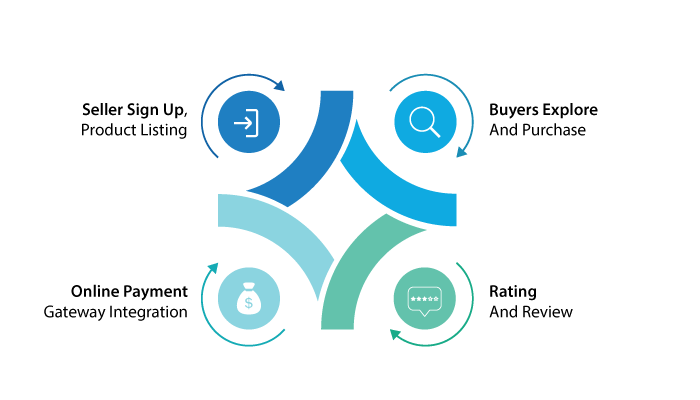
So, how does this million-dollar-worth eCommerce app work? Well, there’s actually a 4 step model that powers Etsy’s business model.
Here, we shall be discussing just that. These are, as mentioned below.
1. Seller Sign Up, Product Listing
The very first step is, to sign up. This is an easy process where the seller needs to put basic information. Moreover, once signed up, the seller can list their product.
As such, the eCommerce app charges a fee for each list that’s valid for 4 months. We shall be discussing more the fee later down the line.
2. Buyers Explore And Purchase
If there are sellers, there have to be users. And here they are.
Once the seller has listed their offering, buyers can explore the items. There are various features such as advanced filters, categories, and so on.
These help users find the products they are looking for. Once they have found something they want to buy, they can talk to the seller or add it directly to the cart.
It’s as simple as that.
3. Online Payment Gateway Integration
To buy something on this Etsy platform or any eCommerce platform for that environment, you need to pay.
Here, you can do it via secure payment integration. Apart from this, there are also options like eWallet integration, and so on.
Coming back to the topic, all the transactions are made only via Etsy’s channel. This is one of the key pieces of information about Etsy’s revenue model.
In any case, the platform charges a 3.5% commission on every successful sale. the rest 96.5% is sent to
All transactions are made through Etsy.
Etsy charges a commission of 3.5% from every successful sale and transfers the rest amount to the seller’s bank account.
4. Rating And Review
Once this sale is made, the buyer gets the delivery and they get an option to review or/and rate the items.
So, this is the four-step working of the platform. And speaking of which, let’s look at the Etsy business model in detail below.
Etsy Business Model
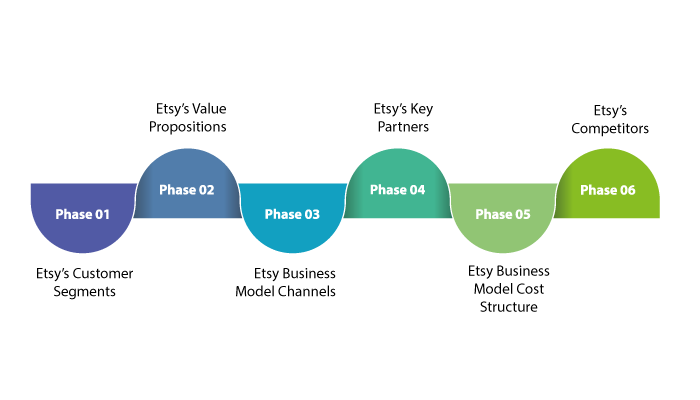
Etsy Business Model is the secret formula behind the success of this eCommerce platform.
So, what is the business model Etsy uses? Well, let’s have a look at it:
The business model this platform follows while being a lot familiar with Amazon has its own differences. Similarities being both are online marketplace solutions where people can buy and sell stuff.
Speaking of differences, the Etsy business model takes a vertical approach rather than a horizontal one like most of the other eCommerce business models.
In layman’s terms, the platform mainly focuses on selling craft items and art-centric pieces. Thus, making the platform very niche specific. As opposed to Amazon which sells pretty much everything.
As Etsy themselves says, “Etsy is home to a universe of special, extraordinary items, from unique handcrafted pieces to vintage treasures”
This is a brief summary of etsy business model. Now, let’s look at the other specifics of the platform.
Etsy’s Customer Segments
So, what’s the customer segment in etsy business model?
Well, since the platform allows people to be both sellers and buyers, you can it’s a two-sided marketplace.
Anyone can sell their art here and anyone can buy it on the platform. Therefore, in a way, this aggregator platform enables C2C business.
Etsy’s Value Propositions
So, what’s the value proposition of the Business model etsy uses? It can be divided into two parts, buyers and sellers.
Let’s see:
Buyers
The main value proposition for the buyers is the unique offering on the platform. Most of the items here are pretty much exclusive. Moreover, the items are delivered to their doorsteps via on-demand delivery services.
Sellers
When it comes to sellers, the biggest value platform is offering is, well, the platform itself. What’s better for artists than a platform for them to sell stuff on? They can showcase and sell their art at a place that has millions of users.
Etsy Business Model Channels
So, what are the marketing channels for Etsy? Let’s have a look at them:
- Etsy eCommerce website SEO
- Etsy App Marketing
- Social media marketing
- Etsy’s workshops and events
- Partnered programs
- Word of mouth Marketing
Etsy’s Key Partners
Unlike many other larger eCommerce platforms that partner with top brands, Etsy is a little different in that way.
The platform rather says, its partners are buyers and sellers. The reason is that it’s a vertical model.
Etsy Business Model Cost Structure
Every platform has a cost structure that follows its revenue model. So, what’s the cost structure of Etsy’s revenue model?
- development and maintenance Cost
- Customer support
- Shipping
- Marketing cost
- Staff salaries
- Seller education initiatives
Etsy’s Competitors
Etsy has its own competitors and there are other apps similar to Etsy. Here are a few of them, mentioned below:
- ArtFire
- Amazon Handmade
- Big Cartel
- eCRATER
- iCraftGifts
- IndieMade:
- Misi:
- Shopify
- Society6
- Volusion
- Zibbet
This was an in-depth analysis of etsy business model
How Etsy Makes Money: Etsy’s Revenue Model
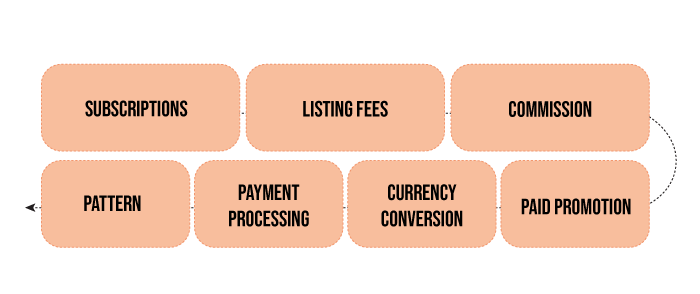
Moment of truth, Etsy’s Revenue Model.
There are a lot of people who ask “how etsy make money?” well, some of the monetization strategies of etsy business model is pretty common.
But there are others that you will love. These are, as mentioned below:
Subscriptions
Etsy business model’s one of best offering is its premium version. Known as Etsy Plus, the version allows sellers to access some extra tools. The fee for this is $10 per month.
Listing fees
If the seller wants to list an item on the Etsy platform they have to pay a fee of at least $0.20. The fee is for 4 months.
This is one of the major revenue streams for etsy business model, considering the fact that there are millions of products on the platform.
Commission
As we already discussed, at every sale, the Etsy platform will charge the seller a 3.5% commission. And again, with the number of items being sold on this platform, the platform generates a lot from the commission.
Pattern
Did you know, with the help of Etsy developers, sellers can create an eCommerce website of their own? Based on the Etsy itself, allows sellers to expand their sales by a large margin.
As such, the pattern shop is free for the first month. From the second month onwards, the platform charges $15.
Payment processing
Every time someone pays for a sale on the platform, the payment gateway processes the payment. And within this process, the platform will charge a fee. And with this, there’s another steam to etsy’s revenue model.
Currency conversion
Etsy e-commerce platform is international. Therefore sometimes there’s a need for currency conversion. Here, the charges for the same are 2.5% of the total amount.
Paid Promotion
Well, well, every seller wants to sell MORE. And they often want to advertise themselves.
Etsy allows this via a popular monetization strategy known as paid promotions. And CPC or cost-per-click generates a lot of revenue for this platform.
Etsy Business Model Infograph
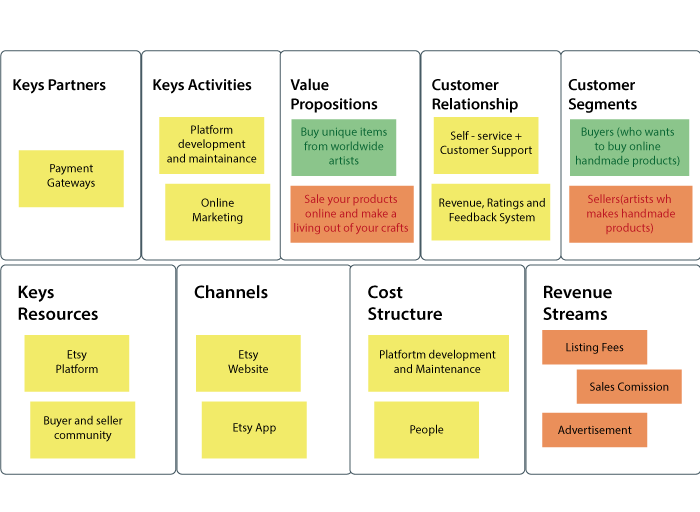
Create An App Like Etsy: Etsy Clone App Development
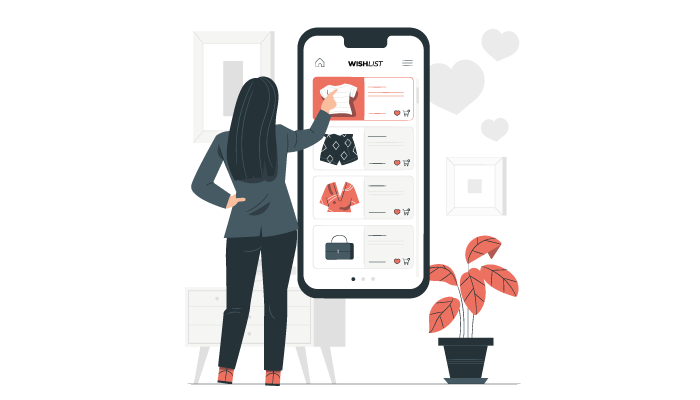
Etsy Business Model is impressive as it has generated millions and billions in revenue for the platforms. And this has attracted a lot of people to create apps similar to etsy.
Now, if you are someone who wants to create an app like Etsy, you are on the right path. Done right, Etsy clone app development can make a lot of revenue and success for you.
In any case, if you have an idea, it’s highly recommended that you consult an eCommerce app development company.
FAQ
Etsy makes money by charging fees to sellers. This includes a listing fee for each item and a commission fee on the sale of each item.
The commission fee on Etsy is currently 5% of the total sale price. This fee is deducted from the payment the seller receives for the item.
The listing fee on Etsy is currently $0.20 per item. This fee is charged each time a new item is listed for sale.
Yes, sellers can offer free shipping on Etsy. However, the cost of shipping must be factored into the price of the item.
Etsy has a system in place that protects both buyers and sellers. Buyers can file a case if they don’t receive their item or if the item they receive is not as described. Sellers can also file a case if they believe a buyer has violated Etsy’s policies.
Yes, you can sell digital items on Etsy. This includes items like printable art, digital downloads, and website templates.
Yes, Etsy offers a variety of marketing tools for sellers. This includes promoted listings, social media integration, and email marketing.

Niketan Sharma is the CTO of Nimble AppGenie, a prominent website and mobile app development company in the USA that is delivering excellence with a commitment to boosting business growth & maximizing customer satisfaction. He is a highly motivated individual who helps SMEs and startups grow in this dynamic market with the latest technology and innovation.
Table of Contents












No Comments
Comments are closed.